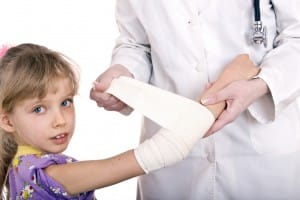How Do You Know if a Toddler Is Hurt After a Fall
Courtesy of Bianca Edison, MD, MS, attending physician in Children'south Orthopaedic Center at Children'southward Hospital Los Angeles It's wonderful to meet children grow and larn new things. But forth with every developmental milestone kids achieve is a new layer of curiosity. Think of kids as fiddling scientists who similar to experiment. They like to see cause and outcome without knowing the risks and because of that, they can get into a bit of trouble and sustain injuries.
 When a child sustains an injury of any type, information technology'south difficult to see them experiencing pain or discomfort. But when that child is an infant or toddler, information technology's often more difficult to define what happened and where they are pain as the child lacks exact communication skills.
When a child sustains an injury of any type, information technology'south difficult to see them experiencing pain or discomfort. But when that child is an infant or toddler, information technology's often more difficult to define what happened and where they are pain as the child lacks exact communication skills.
Here's a staggering statistic: 45 per centum of playground injuries are severe – fractures, dislocations and concussions. That's why it'southward important for parents and caregivers to be aware of the physical cues that accompany common pediatric injuries. These signs can help determine whether a child needs to seek emergency medical care.
Head INJURIES
Caput injuries are extremely common with young children. Signs of a concussion that follow a caput injury are significant and severe crankiness above and beyond what the child normally display, airsickness, slurred speech, exhibiting a difference in the style he/she walks. These symptoms are causes of significant business organisation and demand immediate medical attention.
If a child is less than two years of age and sustains a fall more than than 3 feet, or if a child is over two years of historic period and has sustained a fall more than than 5 feet, a trip to the Emergency Room is in order.
Other significant findings where you lot would want to go to the ER immediately is if a kid has a soft spot on his head, chosen a fontanel, and it feels like it'south jutting. Other concerns are a slowed or undetectable pulse, multiple airsickness episodes or any seizure-type activity. Those symptoms indicate there may increased force per unit area in the encephalon, swelling of the encephalon, or actual bleeding in the brain.
EYE INJURIES
For an eye injury, look for a nosebleed in association with a black center or haemorrhage within the whites of the eye. Y'all should become to the ER if there are 2 black eyes resulting from a head injury, sudden vision changes that are persistent similar seeing double or blurred vision, or if the child has difficulty moving their eyes. Inquire the child to follow your finger. If one middle follows it and the other eye stays straight, or if there's hurting with the movement of the eye, in that location may exist more than meaning trauma to the eye or at that place might be a heart-searching infection within the heart.
MOUTH/TOOTH INJURIES
When children are still learning how to walk or run and coordinate that movement with their growing bodies, they often autumn and injure their mouths and teeth.
If a chief tooth (also known as a baby molar) falls out, information technology's not an emergency, simply a dentist should examine the kid within 24 hours. An injury to permanent teeth is a dental emergency. If a permanent tooth comes out, gently rinse it off with saline (table salt water) or warm milk. Always hold the tooth by the crown only, never past its roots because that can damage the nerves. Once the tooth has been rinsed off, you tin can re-implant information technology the best that you lot can, ensuring correct orientation. Y'all want to exercise this inside 5-20 minutes so the tooth doesn't die and an adult should e'er agree the tooth in place with a moist napkin or paper towel. A kid should not be in charge of this task as they may not agree the tooth still, or the tooth could become dislodged and the child could choke on it. If re-implanting the tooth is hard, identify it in saline or warm milk and then seek emergency treatment. Call up that all missing teeth should be accounted for, and always follow up with your child's dentist to ensure there's not an underlining injury.
FRACTURES
The most mutual injury amongst toddlers and infants is fractures. Common locations where this happens are falling off beds, irresolute tables, sofas, coffee tables and even falling from a standing height. All it takes is the right angle and the right force for a fracture to be sustained. The most common fracture is the clavicle. Other common fractures are the elbow, wrist, legs and fingers.
How do you know if your child has a fracture? Some indicators include immediate swelling at the site of the injury, deformity and reluctance to use that body role (holding an arm close to the body or not putting weight on the leg).
Other signs that should prompt an immediate trip to the ER are the five Ps:
- Pain (extreme discomfort and sensitivity)
- Pallor
- Pulse (weak or not detectable)
- Parasthesia (numbness or tingling)
- Paralysis (inability to move the injured body part)
With a suspected fracture, always take your kid to a facility that has a radiology center and someone there who tin can read the x-rays as before long equally they are taken.
Remember, kids are very active and curious and injuries will occur, no matter how many safety precautions are put in identify. That'due south why it's important to know what to do when something does happen.
barkertheriest1946.blogspot.com
Source: https://www.chla.org/blog/injury-prevention/common-infant-and-toddler-injuries-when-seek-medical-attention
0 Response to "How Do You Know if a Toddler Is Hurt After a Fall"
Post a Comment